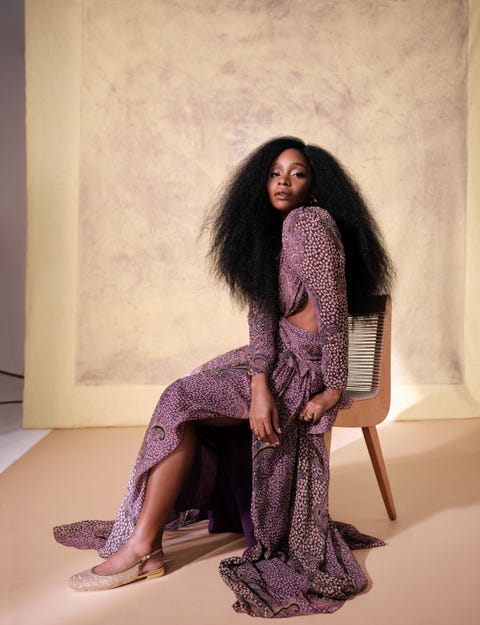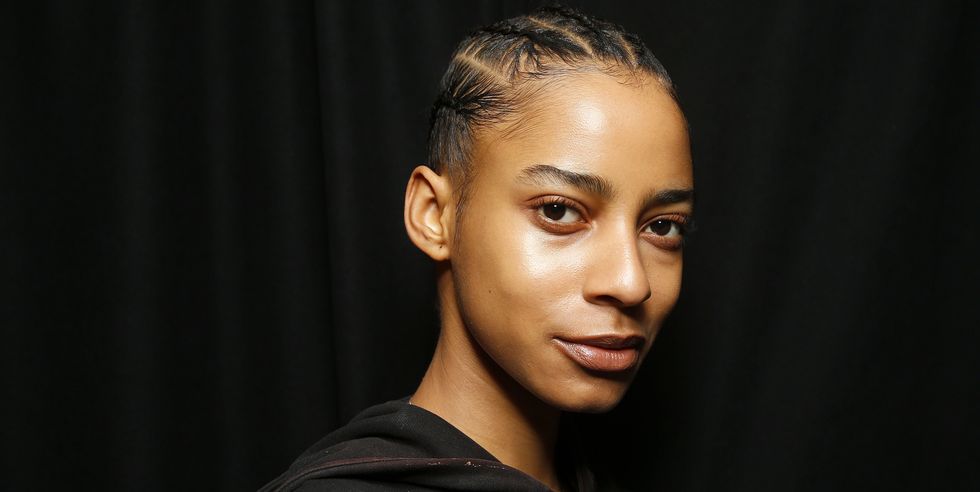Teyonah Parris’s fascination with superheroes began with the Teenage Mutant Ninja Turtles. In a world where most ’90s kids identified with TMNT’s resident reporter April O’Neil, Parris wanted to be a Turtle. She loved their bravado. But did heroes always have to be men? “Turtles are turtles,” Parris says. “But they’re guys.”
So it’s fitting that Parris will now get to have a hand in making superhero history herself. This winter, the actress will become the first female Black character to join the beloved Avengers when she takes on the role of Monica Rambeau in WandaVision, a new Marvel Studios series streaming on Disney+.
For Marvel Cinematic Universe (MCU) fans, WandaVision offers a deeper look at the relationship between Avengers Wanda Maximoff, a.k.a. Scarlet Witch (Elizabeth Olsen), and Vision (Paul Bettany). It also marks the first time the Rambeau character, which originated in The Amazing Spider-Man comic book series, has been seen on screen as an adult. (Akira Akbar played Rambeau as a child in the 2019 Captain Marvel movie.)
The enormity of the role looms large for Parris. “To see that Marvel is going to use this unapologetically Black, unapologetically strong, ambitious woman and bring her into the MCU … I’m so excited by that,” she says. “I feel energized by what this means for the culture, for the world.”
Parris’s path to superhero-dom was forged by a work ethic instilled during her childhood in Hopkins, South Carolina, as the second child—and only girl—in a family of three kids, with parents who encouraged her to think big. “My parents saw a thing in me when I was young that they just nurtured,” she says. “They never told me I couldn’t [do something]. They never said, ‘Who does that? That’s not realistic.’ ”
Parris competed in pageants as a child. But in middle school, she gravitated toward drama class, where she felt there was more space for self-expression. It was her mother who learned about the South Carolina Governor’s School for the Arts and Humanities in Greenville, a conservatory where Parris would spend her formative teenage years learning the craft of acting. And it was a conversation with her father—a Robin Williams superfan—who turned her on to the idea of one day attending Williams’s alma mater, the Juilliard School, in New York. “ ‘That’s where all the good actors go,’ ” Parris recalls him saying. “And I’m like, ‘Well, I’m going to Juilliard.’ ”
And eventually she did. Parris was in the process of graduating—quite literally—when her then manager called to let her know that she’d booked her first-ever professional role in James L. Brooks’s 2010 film, How Do You Know, in which she’d act opposite Reese Witherspoon. “My mom was holding my phone while I walked across the stage during the ceremony,” she says. “And then my phone starts ringing.”
Her breakout came two years later, when she landed a recurring role on Mad Men as Dawn Chambers, Don Draper’s secretary and the first—and, for some time, only—Black employee at the show’s fictional ad agency. Dawn’s storyline would prove pivotal to the final three seasons of Mad Men, and Parris’s work was widely praised.
Then a funny thing happened: On Twitter, Marvel obsessives began fan-casting Parris as different characters—Monica Rambeau among them. “I started looking her up casually,” Parris says. “I thought, ‘Oh, wow, she’s a badass. Probably never going to see the light of day.’ ”
Parris auditioned for a handful of roles in Marvel movies over the years, none of which she got. But she continued to work, with supporting turns in Justin Simien’s Dear White People and Barry Jenkins’s If Beale Street Could Talk, and originated the role of Kaneisha in the off-Broadway production of Jeremy O. Harris’s Slave Play.
In early 2019, Parris’s agent asked her to self-tape another Marvel audition. For what and for whom, Parris did not know; the pages of the script she was sent disguised the characters and context. “I did it, and let it go,” Parris says. Two weeks later, though, she got the call that she’d landed a role. But which one? Her agent started, “I think the character was in Captain Marvel …” Parris instantly knew it was Rambeau.
Parris’s first day at the secretive Marvel “war room” on the Disney lot in Burbank was emotional. Pictures and renderings of her face lined the walls. “I had to take a minute,” she says. “They let me take a walk around the floor. I had to go to the bathroom, and I came out with a roll of toilet paper because I could not stop crying.”
There is a sense of urgency for more visibility for characters like Rambeau, the kind of superhero Parris wishes she’d had to look up to when she was younger. Parris recalls a particularly poignant moment, standing on stage at Comic-Con last year in San Diego. “I was excited because I’m looking out, and there’s my Asian brothers and sisters,” she says. “There’s my Latinx brothers and sisters. And the Black people too. That’s just real. This is what my world looks like. And I’m excited that Marvel is making their universe look like our world at large. It’s just so necessary for young kids to see images that look like themselves.”
Originally posted on “Harper’s Bazaar” by Andrea Cuttler.





No Comments